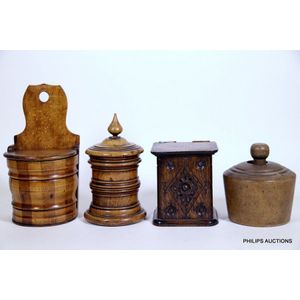Antique Wooden Kitchen Objects Set
You must be a subscriber, and be logged in to view price and dealer details.
Subscribe Now to view actual auction price for this item
When you subscribe, you have the option of setting the currency in which to display prices to $Au, $US, $NZ or Stg.
- Finial - An architectural decoration, found on the upper parts of of an object. On furniture they are usually found on pediments, canopies and shelf supports. On smaller ceramic or silver items, such as spoons, they may decorate the top of the item itself, or the lid or cover where they provide a useful handle for removal.
Finials have a variety of shapes and forms. They may be urn-shaped, baluster shaped round or spiral, but usually taper into an upper point. Many real life shapes may also be used as finials, such as pineapples, berries, pinecones, buds, lotus and acorns. Sometimes animals such as a lion are depicted, or fish and dolphins. - Oak - Native to Europe and England, oak has been used for joinery, furniture and building since the beginning of the medieval civilisation. It is a pale yellow in colour when freshly cut and darkens with age to a mid brown colour.
Oak as a furniture timber was superceded by walnut in the 17th century, and in the 18th century by mahogany,
Semi-fossilised bog oak is black in colour, and is found in peat bogs where the trees have fallen and been preserved from decay by the bog. It is used for jewellery and small carved trinkets.
Pollard oak is taken from an oak that has been regularly pollarded, that is the upper branches have been removed at the top of the trunk, result that new branches would appear, and over time the top would become ball-like. . When harvested and sawn, the timber displays a continuous surface of knotty circles. The timber was scarce and expensive and was used in more expensive pieces of furniture in the Regency and Victorian periods. - Patination / Patina - In broad terms, patination refers to the exterior surface appearance of the timber, the effect of fading caused by exposure to sunlight and air over the course of a century or more, changing the piece to a soft, mellow colour.
As patina is very difficult to replicate, it is one of the most important guides to determining the age of furniture.
Patina is also the term applied to the bloom or film found on old bronzes due to oxidisation.
This item has been included into following indexes:
-
boxes, material or decoration
- boxes, oak 83
- salt boxes 4
- treen - (See also under individual item names) 89
Visually similar items

Peter Stichbury, coffee set, includes stoneware coffee pot, large milk jug, small milk jug, sugar bowl, five mugs all with green and brown glaze. All with impressed mark. Along with an oil pourer by unknown potter (10). Height 23.5 cm. (largest)

Ted Kindleysides, two vessels mounted with elephant and frog lids, impressed marks, 20 cm,19 cm heights (both af)

Early Treen carved 'Frog' lidded pot H11 cm approx

A Martin Boyd ceramic ten piece coffee set, circa 1950
